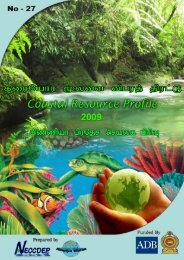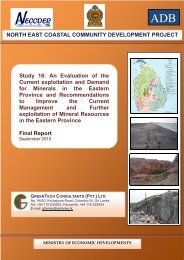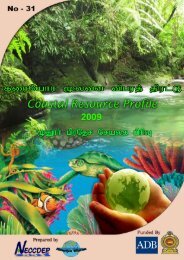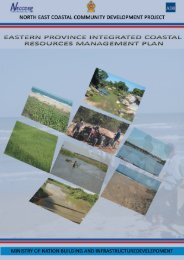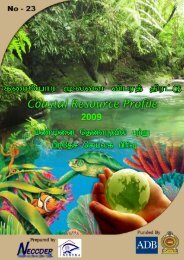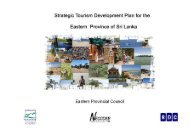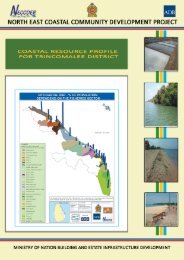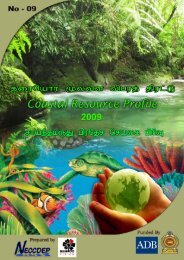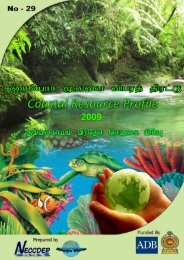Untitled - Neccdep.com
Untitled - Neccdep.com
Untitled - Neccdep.com
Create successful ePaper yourself
Turn your PDF publications into a flip-book with our unique Google optimized e-Paper software.
TRINCOMALEE BAY SPECIAL MANAGEMENT AREA Page | 18<br />
73. After reviewing these studies, NECCDEP identified 19 special studies to provide<br />
additional information. However, the re<strong>com</strong>mendations from these studies were not available<br />
to support the interim SMA process. Indeed a number of these studies are still ongoing and<br />
several have only just been approved to start (November 2009).<br />
74. NECCDEP, therefore, decided to develop the “fast track” interim SMA Plan based on<br />
the findings and re<strong>com</strong>mendations of the studies conducted by other agencies/projects rather<br />
than wait for the results of the special studies.<br />
75. NECCDEP identified 20 environmental issues to be addressed by the interim SMA<br />
Plan based on the review of previous studies and a stakeholders workshop held in<br />
September 2005. The list of these environmental issues is given in Appendix 3.<br />
76. The workshop participants were then asked to select 8 of the 20 issues as core<br />
issues and were asked to suggested remedial actions to address these issues. The selected<br />
8 core issues are given below in priority order.<br />
1. Solid waste collection and disposal including human waste;<br />
2. Degradation of mangrove and coastal vegetation;<br />
3. Destructive Fishing and Collection of Marine Ornamental life;<br />
4. Uncontrolled mining of gravel, clay, sand and shell;<br />
5. Septic tank Pollution and under ground water quality and quantity changes;<br />
6. Destruction of sea-grass beds and coral reef;<br />
7. Coastal erosion;<br />
8. Unplanned tourism and urbanization.<br />
77. The proposed remedial actions and interventions to address these 8 core issues are<br />
given in Appendix 4.<br />
F. Identification of environmental priority areas and interventions<br />
78. NECCDEP appointed a team of officers headed by Officer in Charge of Regional<br />
Office of Central Environmental Authority (CEA) to carry out intensive field studies to select<br />
hotspots. The other members of the study team included relevant District Forest Officers,<br />
Divisional Environmental Officers, respective Land Officers, representatives of local NGO’s<br />
and CBO’s. The team conducted 45 field visits to 69 GN divisions. Previous study reports<br />
were reviewed by the team including the NECCDEP prepared Village Development Plans<br />
(VDP) and Village Social Profiles (VSP). After reviewing the information, the team selected a<br />
list of hotspots and prepared a detailed report, “Identification of environmental priority areas<br />
for Special Management”<br />
79. The study team looked at the inter-relationships between environmental issues and<br />
priority hot spot areas and consolidated then into 4 core-environmental issues. These were:<br />
(i) solid waste collection and disposal; (ii) mangrove habitat loss; (iii) coastal erosion, and; (iv)<br />
localized pollution. These four core environmental issues were then subject to problem tree<br />
analysis or cause-effect analysis which identifies (<strong>com</strong>mon) root causes resulting in issues<br />
(or problems). This is the start of the logical framework analyses which provides the vertical<br />
logic for interventions that resolve the root causes and turn negative problem statements into<br />
positive out<strong>com</strong>e statements.



